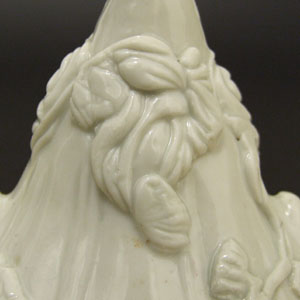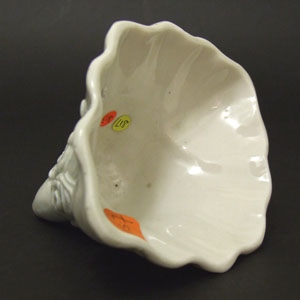
CHONGZHEN to SHUNZHI c.1640 – 1660 Blanc de Chine Porcelain
An Unusual Blanc de Chine Porcelain `Rhinoceros` Horn Cup, Late Ming or Early Qing Dynasty, Chongzhen to Shunzhi c.1640-1660. Dehua Kilns, Fujian Province. The Applied Decoration has a Lot of Hand-tooling, One Side Depicts the Taoist Poet Li Bai (701 – 762), Shown Asleep Next to a Wine Jar with a Cracked-ice Design. The Moulded and Tooled Decoration on the Other Side is of a Person Leaning Over a Weiqi Board While Another Moves a Counter on the Board, with the Sun or Possibly the Moon Above. There is an Area to the Well of the Cup Wiped Clean of Glaze to Support the Piece During Firing.
SOLD
- Condition
- Perfect.
- Size
- Length : 12.5 cm (5 inches)
- Provenance
- The PHDS Wikramaratna Collection of Oriental Ceramics and Works of Art. PHDS Wikramaratna (PH) was born in Ceylon in 1916, coming to London in 1937 where he took a First Class Honours Degree in engineering. He returned to Ceylon at the outbreak of war where he was the first Ceylonese teacher of civil engineering. After settling in the UK with his Dutch-born wife and their family, he gradually built up an extensive collection of Far-Eastern, and mainly Chinese, ceramics, although by no means limited in scope. His antiquities will appear in a later sale. Being in London allowed him to research his finds in the museum showcases, the libraries, the salerooms, and with his many expert friends and acquaintances. As a member of the Oriental Ceramic Society, he often attended meetings and occasionally loaned some of his pieces for OCS exhibitions or gave a lecture. At one time he became a potter to find out more about the techniques used - but according to his wishes, his family has kept these pots. PH had an excellent eye and a feel for the unusual, and his collection contains many pieces which at first glance may appear unexciting but are actually carefully chosen for the ceramics story they have to tell. This sale is an opportunity for both the novice collector and the more experienced. Over the years, PH gave many fine pieces to museums; they can be seen at the British Museum, Victoria and Albert, Ashmolean and Fitzwilliam. PH died in December 2010 and his collection is now coming up for sale. In 1994, Mr Wikramaratna had an inventory taken of the better pieces in the collection and some reference to it has been made in the footnotes, these items have tiny yellow and red numbered stickers. Red label 203, yellow label 217, another larger red label CS 7.
- Stock number
- 22751
- References
- For a blanc de chine porcelain cup of this form and with a similar design see: Blanc de Chine, Porcelain From Dehua, A Catalogue of the Hickley Collection, Singapore (Rose Kerr & John Ayers, Art Media Resources Ltd, 2002) Item 127, and for one with prunus see 126. For a Blanc de Chine cup of this form and with a similar design described as a "Wedding Cup" of "True Rhinoceros" form see : Blanc de Chine (P.J. Donnelly, Faber and Faber, 1969. ISBN 571-08078-2) plate 24a. For another cup of this form see : Blanc de Chine, Divine Images in Porcelain (John Ayres, China Institute Gallery, New York, 2002) page 68, plate 19. For a further Blanc de Chine cup of this form : Blanc de Chine, Divine Images in Porcelain (John Ayres, China Institute Gallery, New York, 2002) For other blanc de chine cups in the form a full Rhinoceros horn see our `Sold Items` numbers 17872 and 19129.
Information
`Rhinoceros` Horn Blanc de Chine Cups :
Rhino horn has a beautiful translucent colour when carved, and from as far back as the Tang Dynasty the Chinese have made ornamental cups and other carvings. One of the more useful purposes of the horn of the Rhinoceros was that when it was made into a drinking cup it was said to have the power to detect poisons. It is thought that this may have been because many early poisons were strong alkaloids that may have reacted strongly with the keratin and gelatin in the rhino horn, thereby indicating the presence of poison. Cups made of this material were also connected with fertility, the ground horn is used in Chinese medicine as an aphrodisiac, so by association drinking from the cup made of Rhino horn or a porcelain one of that shape might help with the bringing of children. This connection is enhanced by Donnelly who points out that a Rhinoceros cup bares an inscription relating to a wedding. Blanc de Chine cups modeled in the form of a full Rhinoceros horn are rare, nearly all shaped Blanc de Chine cups are based on a Rhino horn with the point removed and a decorative base applied. When one looks at the porcelain cups modelled as the whole horn it becomes clear the solid point was lutted on, in other words these cups was made in two parts.
Li Bai / Li Bo :
The Tang dynasty Taoist poet Li Bai, sometimes transliterated as Li Bo, lived from 701 to 762. He is considered the best of the `Romantic Poets` in an age of great poetry, a period often referred to as the golden age of Chinese poetry. His personality fascinated aristocrats and common people alike, Li Bai even meet the emperor. Another Taoist and poet, He Zhizhang, bestowed upon him the nickname "the Transcendent dismissed from the Heaven". Many of the Classical Chinese poets were associated with drinking wine, or more precisely, alcoholic beverages. In fact, Li Bai was part of the group of Chinese scholars during his time in Chang`an, called the "Eight Immortals of the Wine Cup", as mentioned in a poem by fellow poet Du Fu. However, Li Bai is of special note in this respect. As Burton Watson put it, "early all Chinese poets celebrate the joys of wine, but none so tirelessly and with such a note of genuine conviction as Li [Bai]", Or as John C. H. Wu put it, "while some may have drunk more wine than Li [Bai], no one has written more poems about wine." Due to his championship of drunkenness together with his wandering life-style, Li Bai`s poetry has been criticized on moral grounds. But it is as the learned drunken poet that he is depicted in Chinese ceramics, his image has been produced in blanc de chine and Famille Verte as figures, often shown sound asleep next to an empty wine barrel. This image also occurs painted on Kangxi porcelain. The information here is from an article on wikipedia, it has been abridged and adapted, as well as added too.
http://en.wikipedia.org/wiki/Li_Bai
Weiqi / Go :
Known in Chinese as Weiqi and Go in Japan it has similarities to chess. The game is played by two players who alternately place black and white stones on the vacant intersections of a grid of 19×19 lines. The object of the game is to control (surround) a larger portion of the board than the opponent, it is rich in strategy despite its simple rules. Weiqi originated in ancient China more than 2,500 years ago, and although it is not known exactly when the game was invented, by the 3rd century BC it was already a popular pastime, as indicated by a reference to the game in the Analects of Confucius. Go reached the West through Japan, which is why it is commonly known by its Japanese name.
